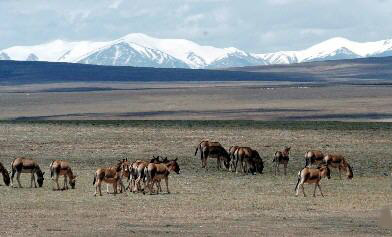Weather experts in the Tibet Autonomous Region in southwest China have warned that global warming is becoming a major threat to the area, widely regarded as a barometer for the world's climate.
"The warming climate has caused an unprecedented number of meteorological disasters in Tibet," the director of the Tibet regional meteorological bureau, Song Shanyun, said.
"Problems like receding snow lines, shrinking glaciers, drying grasslands and desertification are increasingly threatening the region's ecosystem.
"Natural disasters, like droughts, landslides, snowstorms and fires are more frequent and calamitous now. The tolls are more severe and losses are greater," he said.
Song cited two major disasters in 2000, which caused total losses of 1.4 billion yuan (US$188 million).
In April 2000, a thawed snow cap triggered what experts described as a "rare and extremely large-scale" landslide in Nyingchi Prefecture in southeast Tibet.
More than 300 million cu m of debris, piling up to 100 m high, blocked a river and affected more than 4,000 people.
The other disaster was in the city of Xigaze in southern Tibet, where a flood of the size that usually occurs only once in a century affected more than 60,000 people and inundated thousands of hectares of cropland.
The region, home to the Qinghai-Tibet Plateau, has been experiencing various signs of global warming.
A study by the weather bureau shows the temperature in Tibet rising by 0.3 C every decade, about 10 times the speed of the national average of 0.4 C every century.
"The temperature rise in Tibet is only a microcosm of the global warming trend," Zhang Hezhen, a senior engineer with the bureau, said.
Tibet has also just experienced its third warmest winter in the last seven years, between December last year and February this year, with a temperature rise of 9 C in some areas.
Statistics show that glaciers on the area's plateau have melted at an annual rate of about 131 sq km over the past three decades.
In a sign of the worsening situation, scientists have warned that Mount Qomolangma - the world's tallest peak - which sits in the southern part of Xigaze at 8,844.43 m above sea level, will eventually lose its cover of snow and ice if global warming continues to melt glaciers on the plateau.
All About Global warming, Qinghai-Tibet Plateau
(Xinhua News Agency November 22, 2007)






